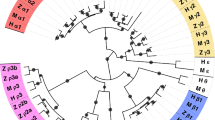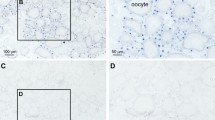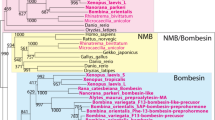Abstract
The neuropeptide receptors which are present in very small quantities in the cell and are embedded tightly in the plasma membrane have not been well characterized. Mammals contain three distinct tachykinin neuropeptides, substance P, substance K and neuromedin K, and if has been suggested that there are multiple tachykinin receptors1,2. By electrophysiological measurement, we have previously shown that Xenopus oocytes injected with brain and stomach mRNAs faithfully express mammalian substance-P and substance-K receptors, respectively3. Here we report the isolation of the cDNA clone for bovine substance-K receptor (SKR) by extending this method to develop a new cloning strategy. We constructed a stomach cDNA library with a cloning vector that allowed in vitro synthesis of mRNAs and then identified a particular cDNA clone by testing for receptor expression following injection of the mRNAs synthesized in vitro into the oocyte system. Because oocytes injected with exogenous mRNAs can express numerous receptors and channels, our new strategy will be applicable in the geperal molecular cloning of these proteins. The result provides the first indication that the neuropeptide receptor has sequence similarity with rhodopsin-type receptors (the G-protein-coupled receptor family) and thus possesses multiple membrane-spanning domains.
This is a preview of subscription content, access via your institution
Access options
Subscribe to this journal
Receive 51 print issues and online access
$199.00 per year
only $3.90 per issue
Buy this article
- Purchase on Springer Link
- Instant access to full article PDF
Prices may be subject to local taxes which are calculated during checkout
Similar content being viewed by others
References
Quirion, R. Trends Neurosci. 8, 183–185 (1985).
Nakanishi, S. Physiol. Rev. (in the press).
Harada, Y. et al. J. Neurosci. (in the press).
Maniatis, T., Fritsch, E. F. & Sambrook, J. Molecular Cloning, a Laboratory Manual (Cold Spring Harbor Laboratory, New York, 1982).
Krieg, P. A. & Melton, D. A. Nucleic Acids Res. 12, 7057–7070 (1984).
Sanger, F., Nicklen, S. & Coulson, A. R. Proc. natn. Acad. Sci. U.S.A. 74, 5463–5467 (1977).
Kyte, J. & Doolittle, R. F. J. molec. Biol. 157, 105–132 (1982).
Lipman, D. J. & Pearson, W. R. Science 227, 1435–1441 (1985).
Engelman, D. M., Goldman, A. & Steitz, T. A. Meth. Enzym. 88, 81–88 (1982).
Ovchinnikov, Y. A. FEBS Lett. 148, 179–191 (1982).
Nathans, J. & Hogness, D. S. Cell 34, 807–814 (1983).
Dixon, R. A. F. et al. Nature 321, 75–79 (1986).
Kubo, T. et al. Nature 323, 411–416 (1986).
Kubo, T. et al. FEBS Lett. 209, 367–372 (1986).
Peralta, E. G. et al. Science 236, 600–605 (1987).
Henderson, R. & Unwin, P. N. T. Nature 257, 28–32 (1975).
Dohlman, H. G., Caron, M. G. & Lefkowitz, R. J. Biochemistry 26, 2657–2664 (1987).
Hubbard, S. C. & Ivatt, R. J. A. Rev. Biochem. 50, 555–583 (1981).
Blobel, G. & Dobberstein, B. J. Cell Biol. 67, 852–862 (1975).
Buck, S. H. & Burcher, E. Trends pharmac. Sci. 7, 65–68 (1986).
Sumikawa, K., Houghton, M., Emtage, J. S., Richards, B. M. & Barnard, E. A. Nature 292, 862–864 (1981).
Smart, T. G., Houamed, K. M., van Renterghem, C. & Constanti, A. Biochem. Soc. Trans. 15, 117–122 (1987).
Yanisch-Perron, C., Vieira, J. & Messing, J. Gene 33, 103–119 (1985).
Watson, C. J. & Jackson, J. F. in DNA Cloning, a Practical Approach Vol. 1 (ed. Glover, D. M.) 79–88 (IRL, Oxford, 1985).
Huynh, T. V., Young, R. A. & Davis, R. W. in DNA Cloning, a Practical Approach Vol. 1 (ed. Glover, D. M.) 49–78 (IRL, Oxford, 1985).
Author information
Authors and Affiliations
Rights and permissions
About this article
Cite this article
Masu, Y., Nakayama, K., Tamaki, H. et al. cDNA eloping of bovine substance-K receptor through oocyte expression system. Nature 329, 836–838 (1987). https://doi.org/10.1038/329836a0
Received:
Accepted:
Issue Date:
DOI: https://doi.org/10.1038/329836a0
This article is cited by
-
Sex-specific expression of pheromones and other signals in gravid starfish
BMC Biology (2022)
-
Expression cloning human and rat renal cortex Na/Pi cotransporters: behind the scenes in the Murer laboratory
Pflügers Archiv - European Journal of Physiology (2019)
-
Weighted Correlation Network Analysis (WGCNA) of Japanese Flounder (Paralichthys olivaceus) Embryo Transcriptome Provides Crucial Gene Sets for Understanding Haploid Syndrome and Rescue by Diploidization
Journal of Ocean University of China (2018)
-
A historical perspective on the role of sensory nerves in neurogenic inflammation
Seminars in Immunopathology (2018)
-
A tachykinin-like neuroendocrine signalling axis couples central serotonin action and nutrient sensing with peripheral lipid metabolism
Nature Communications (2017)
Comments
By submitting a comment you agree to abide by our Terms and Community Guidelines. If you find something abusive or that does not comply with our terms or guidelines please flag it as inappropriate.



